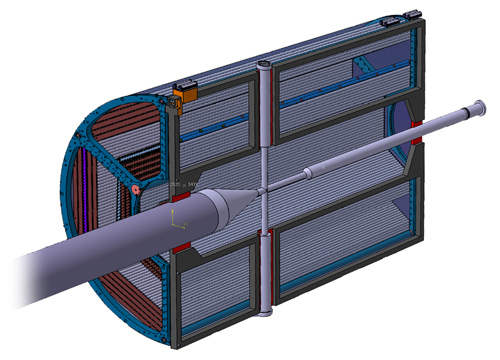Contact: Paola Gianotti
A straw tube is basically a single channel drift tube, i.e. a gas filled tube with a wire along its axis. A high voltage of some kV is applied between the wire and the tube so that an electric field is present in the gas filled area. When a charge particle transverses the straw tube, ionization takes place; the electrons drift toward the wire, while the ions drift toward the wall. Once the electrons are near enough to the wire (~50 μm), an avalanche multiplication takes place with an amplification of 104 - 105 of the primary charge, which allows the readout of the electric signal. The arrival time of the signal defines the drift radius, and the charge collected is proportional to the particle energy lost by ionization.
The PANDA Straw Tube Tracker consists of an ensemble of 150 cm long drift tubes, arranged in a cylindrical volume around the beam axis. The basic module is a planar double-layer of tubes in order to resolve the left-right ambiguity of the track position with respect to the wire.
Concerning the gas choice, it is necessary to find a compromise between the material budget, which must be small to minimize the multiple scattering, and a good spatial resolution. An Ar/CO2 gas mixture (90/10) has been chosen for the PANDA straw tubes.
| STT Internal radius | 15 cm |
|---|---|
| STT External radius | 42 cm |
| Number of double layers | 12 |
| Skew angle double layer 5 | +3o |
| Skew angle double layer 6 | -3o |
| Tube wall thickness | 30 μm |
| Tube internal diameter | 10 mm |
| Axial tube length | 150 cm |
| Wire diameter | 20 μm |
| Tube wall material | Al-Mylar |
| Wire material | Au plated W/Re |
| Gas mixture | Ar/CO2 (90/10) |
| Single tube transparency | 3.7 x 10-4 X/X0 |
| ρ/φ plane resolution | 150μm |
| z resolution | 1 mm |






